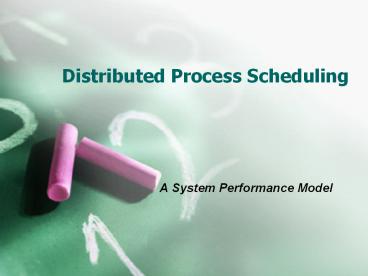A System Performance Model PowerPoint PPT Presentation
1 / 20
Title: A System Performance Model
1
Distributed Process Scheduling
- A System Performance Model
2
Outline
- Overview
- Process Interaction Models
- A System Performance Model
- Efficiency Loss
- Processor Pool and Workstation Queuing Models
- Comparison of Performance for Workload Sharing
- References
3
For concurrent execution of interacting
processes-
- Communication and
- Synchronization between processes
- are the two essential system
components - Before processes can execute, they need to be-
- Scheduled and
- Allocated with resources.
4
Why scheduling?
- 1.To enhance overall system performance metrices
like - Process completion time and
- Processor utilization.
- 2. To achieve location and performance
transparencies by distributed process scheduling.
5
Why scheduling in distributed systems is of
special interest
- This is so because of the issues that are
different from those in traditional
multiprocessor systems - The communication overhead is significant.
- The effect of underlying architecture cannot be
ignored. - And the dynamic behaviour of the system must be
addressed.
6
Process Models(in brief)
- Precedence Process Model
- Processes are represented by a DAG.
- Nodes- sequential processes
- Arcs- eg i to j requires that process I
completes before j can start executing.
7
Communication Process Model
- Processes are created to coexist and communicate
synchronously. - So we have undirected edges.
8
Disjoint Process Model
- We assume that processes can be run independently
of each other. - So order in which processes are executed is not
important.
9
System Performance
- Speedup
- -What are the factors on which it depends
- How to calculate speedup when we apply these
factors
10
Speedup depends on three factors
- The design of the algorithm
- The efficiency of the scheduling algorithm
- The underlying system architecture.
- So if we take S as the speedup factor then the
above dependencies can be represented as - S F(Algorithm, System, Schedule)
11
- Where
- OSPT optimal sequential processing time the
best time that can be achieved on a single
processor using the best sequential algorithm. - CPT concurrent processing time actual time
achieved with the concurrent algorithm on an
ideal n-processor system using an optimal
scheduling policy. - OCPTideal optimal concurrent processing time on
an ideal system - Si ideal speedup obtained by using a multiple
processor system over the best sequential time - Sd the degradation of the system due to actual
implementation compared to an ideal system
12
Refined formula for speedup..
- n number of processors
- RP- Relative Processing requirement,
- RC- Relative Concurrency
13
. Refined formula for speedup
- Sd- degradation of parallelism due to algorithm
implementation.
14
Final formula for speedup
- ?- Efficiency Loss, loss of parallelism when
implemented on a real machine. - ? can be decomposed into two terms
- ? ?sched ?syst
15
Efficiency Loss ?
16
Efficiency Loss ? (Cont.)
17
Workload Distribution
- Performance can be further improved by workload
distribution - Load sharing static workload distribution
- Dispatch process to the idle processors
statically upon arrival - Corresponding to processor pool model
- Load balancing dynamic workload distribution
- Migrate processes dynamically from heavily loaded
processors to lightly loaded processors - Corresponding to migration workstation model
18
Processor-Pool and Workstation Queueing Models
Static Load Sharing
Dynamic Load Balancing
M for Markovian distribution
19
Comparison of Performance for Workload Sharing
20
References
- Distributed Operating Systems and Algorithms by
Randy Chow and Theodore Johnson - Operating System Concepts by Silberschatz,
Galvin and Gagne

